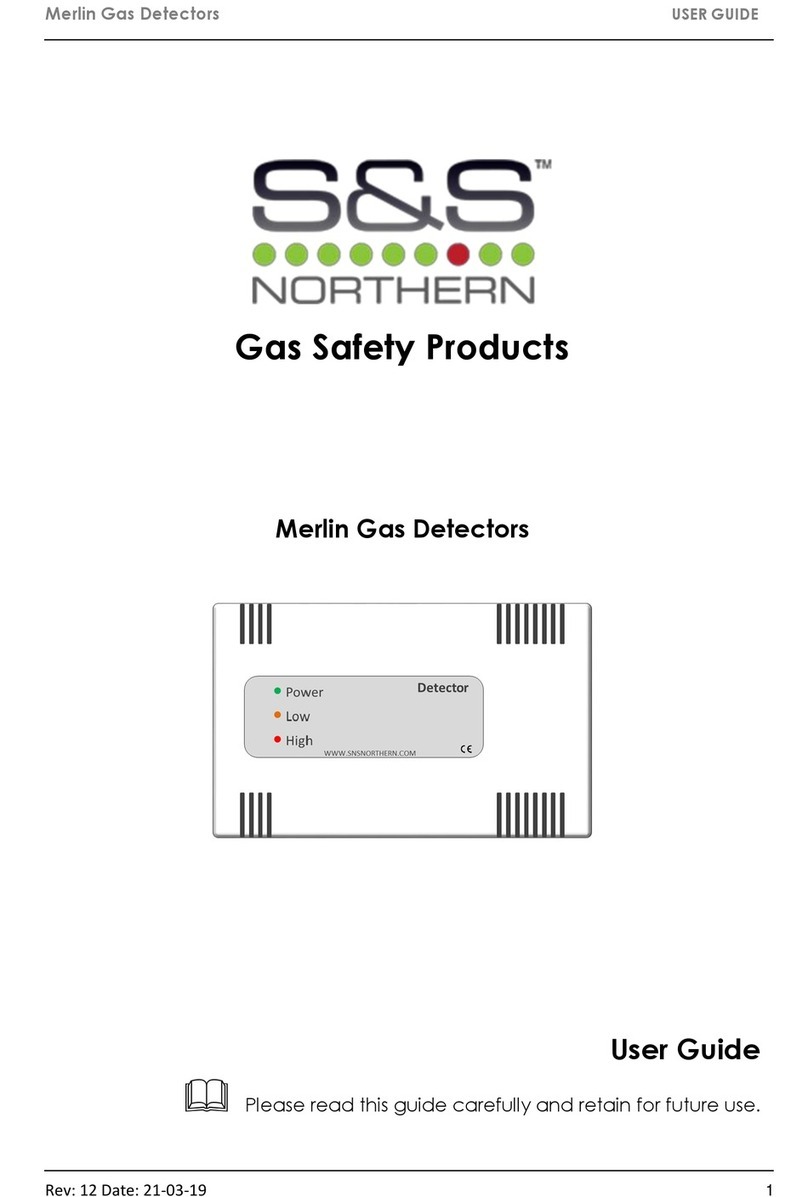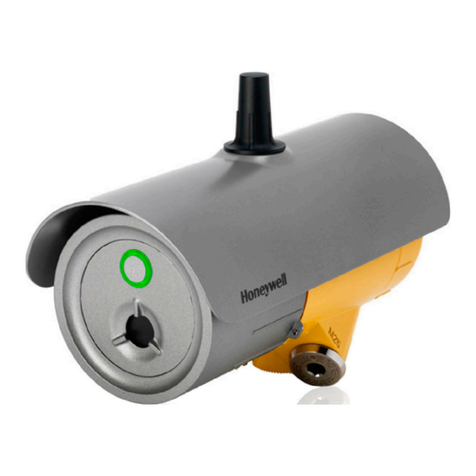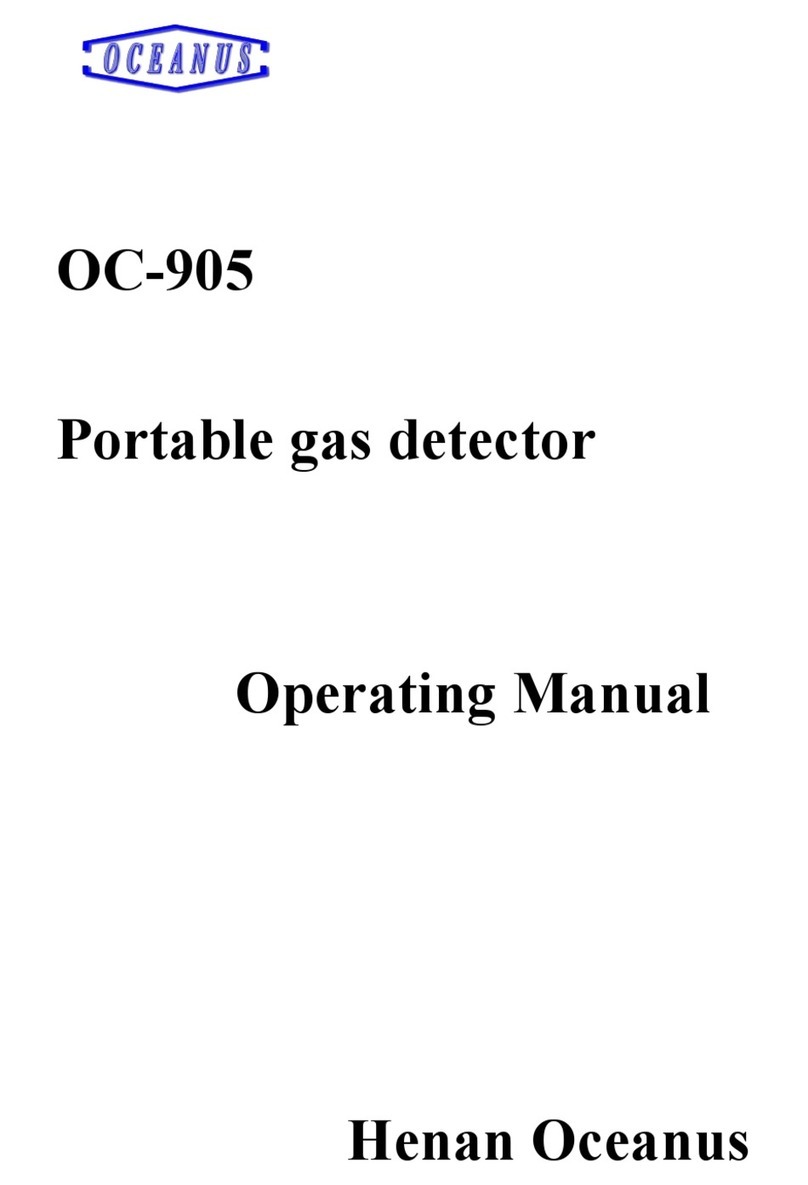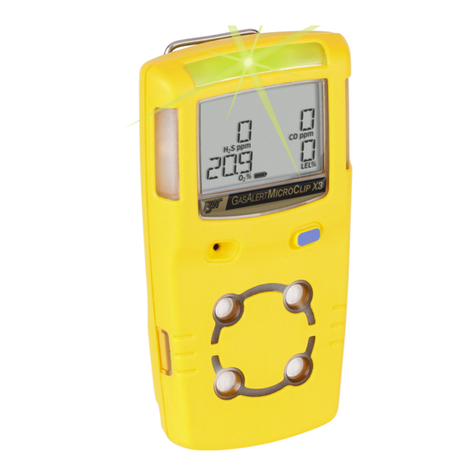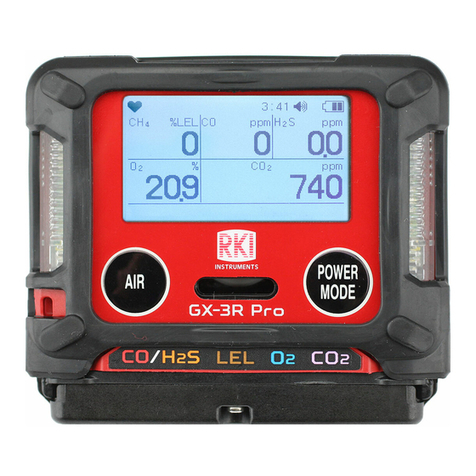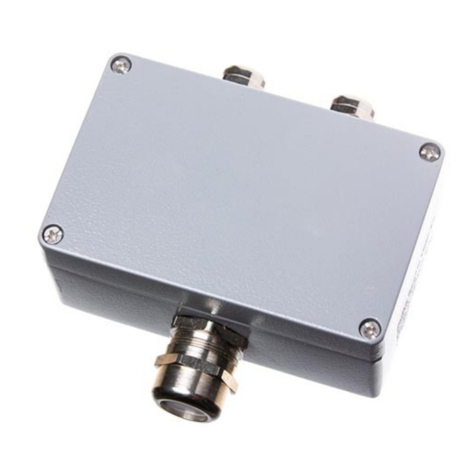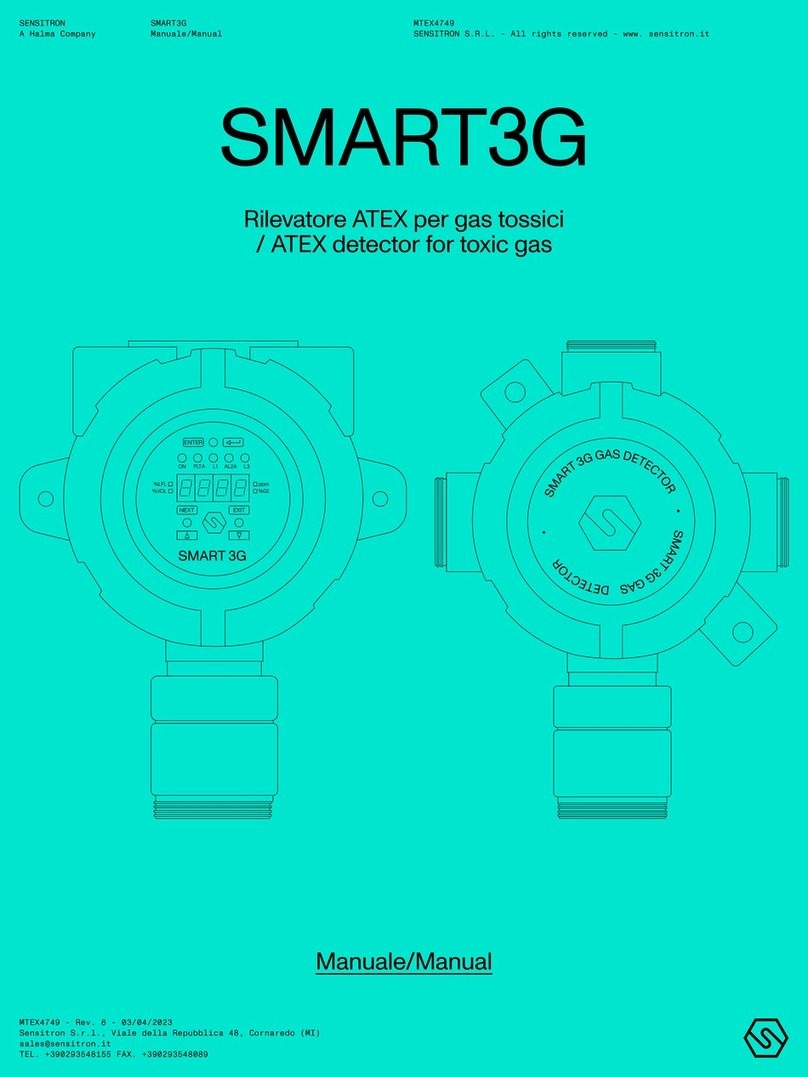HESA FD-DG024 User manual

Istruzioni
Instructions
DT02309HE0913R00
Rivelatori di gas
per uso domestico
Residential Gas Detectors
FD-DG024 (cod. HCRGPM12)
FD-DG230 (cod. HCRGPM23)

DT02309_HE0913R00
Avvertenze
Warning
QUESTO MANUALE DEVE ESSERE LETTO
ATTENTAMENTE DA TUTTI COLORO CHE
HANNO O AVRANNO LA RESPONSABILITA DI
INSTALLARE, UTILIZZARE O DI PRESTARE
ASSISTENZA SU QUESTO PRODOTTO.
Come ogni strumento, questo prodotto funzionerà
correttamente solo se installato, utilizzato e
controllato come prescritto dal fabbricante.
IN CASO CONTRARIO, POTREBBE NON
FUNZIONARE COME PREVISTO E LE
PERSONE CHE AFFIDANO LA LORO
INCOLUMITA A QUESTO PRODOTTO
POTREBBERO SUBIRE DANNI PERSONALI
O LETALI.
La garanzia riconosciuta da HESA S.p.A. su
questo prodotto potrebbe essere nulla se non
venisse installato, utilizzato e controllato secondo le
istruzioni fornite con il presente manuale. Per
favore, proteggetevi seguendole attentamente.
Invitiamo i nostri clienti a scriverci o a chiamarci per
ogni informazione riguardo questo strumento, il suo
uso o una sua eventuale riparazione.
THIS MANAUL MUST BE CAREFULLY READ
BY ALL PERSONS WHO HAVE OR WILL
HAVE THE RESPONSIBILITY FOR
INSTALLING, USING OR SERVICING THIS
PRODUCT.
Like any equipment, this product will perform as
designed only if installed, used and serviced in
accordance with the manufacturer’s instructions.
OTHERWISE, IT COULD FAIL TO PERFORM
AS DESIGNED AND PERSONS WHO RELY
ON THIS PRODUCT FOR THEIR SAFETY
COULD SUFFER SEVERE PERSONAL
INJURY OR DEATH.
The warranties made by HESA S.p.A. with respect
to this product are voided if the product is not
installed, used and serviced in accordance with the
instructions in this user guide. Please protect
yourself and others by following them.
We encourage our customers to write or call
regarding this equipment prior to use or for any
additional information relative to use or repair.

DT02309_HE0913R00
INDICE
Descrizione .................................................................................................................................................................................... 3
Istruzioni per l’installazione ............................................................................................................................................................ 4
Funzionamento .............................................................................................................................................................................. 5
Attivazione Relè ............................................................................................................................................................................. 6
Posizionamento.............................................................................................................................................................................. 7
Manutenzione e verifiche ............................................................................................................................................................... 7
Informazioni sull’importanza di rilevare gas esplosivi..................................................................................................................... 8
In caso di allarme: ...................................................................................................................................................................... 8
Informazioni sulla tossicità del monossido di carbonio (CO) .......................................................................................................... 9
EN 50291 ................................................................................................................................................................................. 10
In caso di allarme: .................................................................................................................................................................... 10
Cablaggio..................................................................................................................................................................................... 11
Tagliando di GARANZIA per la modalità di riparazione ............................................................................................................... 12
CONTENTS
Description ..................................................................................................................................................................................... 3
Installation instructions................................................................................................................................................................... 4
Operation ....................................................................................................................................................................................... 5
Relay activation.............................................................................................................................................................................. 6
Positioning ..................................................................................................................................................................................... 7
Maintenance and inspection .......................................................................................................................................................... 7
Information on the importance of detecting explosive gases.......................................................................................................... 8
If an alarm occurs:...................................................................................................................................................................... 8
Information on the toxicity of carbon monoxide (CO) ..................................................................................................................... 9
EN 50291 ................................................................................................................................................................................. 10
If an alarm occurs:.................................................................................................................................................................... 10
Electric Wiring .............................................................................................................................................................................. 11
WARRANTY coupon for repairing................................................................................................................................................ 12

DT02309_HE0913R00
Descrizi ne
Descripti n
I rilevatori di gas sono stati realizzati per
strumenti di elevata tecnologia e affidabilità
per la rilevazione in ambiente domestico di Metano,
GPL e Monossido di Carbonio.
I rivelatori utilizzano sensori catalitici per
rilevare Metano, GPL e celle elettrochimiche per
monossido di carbonio.
I segnali sono gestiti da un microprocessore.
I rilevatori sono stati realizzati per in conformità alle
normative Europee in ambito di sicurezza gas
(EN50194 e EN50291).
gas detectors have been designed to
offer technologically advanced and accurate
instruments for Methane, LPG and Carbon
Monoxide detection in residential environment.
gas detectors are microprocessor based
and employ professional catalytic sensors for
Methane, LPG detection and electrochemical cells
for Carbon Monoxide.
These gas detectors comply with the European
standards concerning the safety of gases in
residential premises (EN50194 and EN50291)
TABELLA 1 ALLARMI GAS / TABLE 1 GAS ALARMS
MODELLO
MODEL
GAS RILEVATO
GAS DETECTED
ALLARME 1
ALARM 1
ALLARME 2
ALARM 2
EU STANDARD ALIMENTAZIONE
POWER SUPPLY
FD
METANO o GPL
METHANE or LPG
5% LEL 10% LEL EN50194 230Vac or 12-24Vdc
TABELLA 2 CARATTERISTICHE ELETTRICHE / TABLE 2 ELECTRICAL FEATURES
Modelli e codici
Models and P/N
FD-DG230
FD-DG24
Alimentazione
Power supply
230 Vac 12-24Vdc
Assorbimento
Consumption
40 mA 150 mA
Portata relé
Contacts rating
8A, 250V 8A, 250V
, 250V
Temperatura di funzionamento
Operating temperature
-10°C ÷ +45°C -10°C ÷ +45°C
Temperatura di stoccaggio
Storage temperature.
-20°C ÷ +60°C -20°C ÷ +60°C
Umidità
Relative humidity
15-90% RH 15-90% RH
Fusibile / Fuse 125mA 315mA

DT02309_HE0913R00
Istruzi ni per l’installazi ne
Installati n instructi ns
ATTENZIONE:
Leggere attentamente ed attenersi
scrup l samente alle indicazi ni
f rnite.
L INSTALLAZIONE DEL RILEVATORE DI GAS
NON ESONERA DALL OSSERVANZA DI TUTTE
LE REGOLE PER L INSTALLAZIONE E L USO
DEGLI APPARECCHI A GAS, PER LA
VENTILAZIONE DEI LOCALI E PER LO SCARICO
DEI PRODOTTI DELLA COMBUSTIONE
PRESCRITTI DALLE NORME DI SICUREZZA UNI-
CIG E DALLE DISPOSIZIONI DI LEGGE
IL RIVELATORE NON DEVE ESSERE
INSTALLATO VICINO AD APPARECCHI DI
COTTURA, LAVELLI, ASPIRATORI, VENTILATORI
E DOVUNQUE LE CONDIZIONI AMBIENTALI
SIANO DIVERSE DA QUELLE DI
FUNZIONAMENTO PREVISTE E QUI INDICATE
ATTENTION:
Read carefully and strictly f ll w all the
instructi ns pr vided.
THE INSTALLATION OF A GAS DETECTOR
DOES NOT RELIEVE THE USER FROM
COMPLYING WITH ALL THE REGULATIONS
CONCERNING THE INSTALLATION AND USE OF
GAS EQUIPMENT, THE AMBIENT VENTILATION
AND FLUE GAS EXHAUSTING PRESCRIBED BY
THE SAFETY REGULATIONS IN FORCE IN EACH
COUNTRY.
THE DETECTOR SHOULD NOT BE INSTALLED
CLOSE TO COOKING APPLIANCES, SUCTION
BASINS, FANS AND IN AREAS WHERE
ENVIRONMENTAL CONDITIONS DIFFER FROM
THOSE RECOMMENDED AND SPECIFIED IN
THIS DOCUMENT.
AVVERTENZA
RIVOLGERSI
A
TECNICI
AUTORIZZATI
PER
L INSTALLAZIONE,
LA
MANUTENZIONE
ORDINARIA
E
STRAORDINARIA.
DURANTE L'INSTALLAZIONE IL TECNICO
DOVRA' INDICARE LA DATA DI SOSTITUZIONE
SULLA TARGA POSTA SUL RIVELATORE.
LA SOSTITUZIONE DEVE AVVENIRE ENTRO 4
ANNI DALLA DATA D'INSTALLAZIONE.
ALLO
SCADERE
DEL
PERIODO
DI
FUNZIONAMENTO
QUI
DICHIARATO,
SEGUIRE
LE
PROCEDURE
PER
LA
MESSA
FUORI
SERVIZIO.
SI RICORDA CHE:
WARNING
INSTALLATION,
ORDINARY
AND
EXTRAORDINARY
MAINTENANCE
SHOULD
ALWAYS
BE
CARRIED
OUT
BY
QUALIFIED
TECHNICIANS.
AT THE MOUNTING PHASE, THE TECHNICIAN
WILL HAVE TO WRITE THE REPLACEMENT DATE
ON THE LABEL STUCK ON THE DETECTOR.
DETECTORS ARE TO BE REPLACED 4 YEARS
AFTER THE INSTALLATION.
ONCE
THE
ESTIMATED
LIFETIME
IS
OVER,
DISPOSAL
SHOULD
BE
CARRIED
OUT
IN
ACCORDANCE
WITH
THE
INSTRUCTIONS
PROVIDED
IN
THIS
DOCUMENT.
WE
REMIND
YOU
THAT:
-IL
RIVELATORE
E
IDONEO
SOLO
PER
LA
RIVELAZIONE
DI
GAS
IN
AMBIENTE
DOMESTICO.
-THIS GAS DETECTOR HAS BEEN DESIGNED
SOLELY TO BE EMPLOYED FOR
RESIDENTIAL USE
-IL
RIVELATORE
NON
DEVE
ESSERE
ESPOSTO
AI
RAGGI
DIRETTI
DEL
SOLE
-THE DETECTOR SHOULD NEVER BE
EXPOSED TO DIRECT SUNLIGHT.
-IL RILEVATORE NON DEVE MAI ESSERE
VERNICIATO
-THE
DETECTOR
SHOULD
NEVER
BE
PAINTED

DT02309_HE0913R00
Funzi nament
Operati n
Al momento della connessione dell’apparecchio alla
tensione di alimentazione si verifica quanto segue:
-il relè si porta immediatamente in sicurezza
eccitandosi (jumper J25 in posizione 2-3);
-per 90 secondi circa lo strumento è in fase di
riscaldamento e durante tale fase lo strumento non
è in grado di rilevare eventuali fughe di gas.
Al termine di questa fase deve rimanere acceso il
solo LED verde che indica il corretto funzionamento
dell’apparecchio.
Se quanto specificato non dovesse accadere
scollegare lo strumento e contattare il centro
d’assistenza.
Una situazione di ‘ALLARME 1’ si genera quando
la concentrazione di gas in ambiente supera il
livello indicato nella TABELLA 1. Il LED rosso si
accende e resta acceso fino al persistere in aria
della concentrazione di gas. E’ previsto un ciclo di
isteresi che impedisce alle segnalazioni di allarmi di
attivarsi e disattivarsi in un prossimità del punto di
allarme.
Una situazione di ‘ALLARME 2’ si genera quando
la concentrazione di gas in ambiente supera il
livello indicato nella TABELLA 1: sullo strumento si
accende il relativo LED rosso, si attiva il cicalino
interno a suono continuo e si attiva il relè (jumper
J24 in posizione 7-8). Tale condizione permane fino
al persistere in aria della concentrazione di gas.
E’ previsto un ciclo di isteresi che impedisce alle
segnalazioni di allarmi di attivarsi e disattivarsi in
prossimità del punto di allarme.
Una situazione di ‘FAULT’ (guasto) si genera
quando il sensore o qualche parte elettronica si
guasta: sullo strumento si accende il LED giallo
‘FLT’, interviene il cicalino e si attiva il relè (jumper
J24 in posizione 7-8).
In questo caso scollegare lo strumento e contattare
il centro d’assistenza.
Once the detector is connected to the power
supply, the following procedures occur:
-the relay enters in safety mode and energizes
(jumper J25 in position 2-3).
-for nearly 90 seconds the detector is in warm-up
phase and throughout this time it is unable to detect
gas leaks.
Once the warm up phase is over, ONLY the green
LED should be on to indicate that the detector is
properly working.
Should the above procedure not occur, please
disconnect the detector from the power supply and
contact a service center.
The ALARM 1’ condition occurs when the
environmental gas concentration exceeds the value
shown in TABLE 1. In this case, the red LED turns
on and remains active until the gas concentration
falls below the threshold. The detector has a
hysteresis function that prevents the alarms from
triggering and un-triggering close to the alarm
points.
The ‘ALARM 2’ condition occurs when the
environmental gas concentration is above the value
shown in TABLE 1. In this case, the red LED turns
on, the buzzer generates a continuous alarm and
the relay activates (jumper J24 position 7-8). This
condition is maintained until the concentration of
gas falls below the threshold.
The detector has a hysteresis function that prevents
alarms from triggering and un-triggering close to the
alarm point.
The ‘FAULT’ condition occurs when a failure or
problem occurs to the sensor or to any other
electronic part. This causes the yellow ‘FLT’ LED to
switch on and both the buzzer and the relay to
activate (jumper J24 position 7-8). If this condition
occurs, it is necessary to disconnect the detector
and have it serviced by a qualified service center.
l rilevatori sono inoltre dotati di una segnalazione
WD relativa al dispositivo di controllo del
microprocessore che si attiva in caso di anomalie di
funzionamento.
The detectors have a WD signaling for the
microprocessor control system that activates if
faults occur during operation.

DT02309_HE0913R00
Attivazi ne Relè
Relay activati n
Tramite i jumper J24 e J25 è possibile selezionare
l attivazione del relè in base alla soglia d allarme ed
al grado di sicurezza desiderato.
Si consiglia di non modificare la disposizione dei
jumper impostata dal fabbricante, poiché solo essa
garantisce la conformità alle norme europee.
Jumpers J24 and J25, allow setting the relay
intervention both considering the operating mode
and the alarm threshold.
We recommend not to modify the default factory set
configuration as this one assures compliance with
the EN standards.
Tramite il jumper J24 è possibile selezionare la
s glia d'allarme su cui far attivare il relè:
Jumper J24 can be used to select the alarm
thresh ld associated to the relay activation:
- Posizione 1-2 scatta il relè su Allarme 1 - Position 1-2 relay activates to Alarm 1
- Posizione 3-4 scatta il relè su Allarme 2 - Position 3-4 relay activates to Alarm 2
- Posizione 5-6 scatta il relè su Fault - Position 5-6 relay activates to Fault
- P sizi ne 7-8 scatta il relè su Allarme 2 Fault
(p sizi ne di default)
- P siti n 7-8 relay activates t Alarm 2 r Fault
(default c nfigurati n)
N.B.: Il buzzer si attiva s l c n il jumper
p sizi nat su 7-8 e non è possibile impostarlo
diversamente.
N.B.: Buzzer activates nly with jumper
p siti ned t 7-8 and cannot be set otherwise.
Tramite il jumper J25 è possibile selezionare la
m dalità d’intervent del relè:
Jumper J25 can be used to select the relay
perating m de:
-in p sizi ne 2-3 il relè è normalmente eccitato e
lavora in sicurezza p sitiva (c nfigurazi ne di
default). Se si dovesse verificare un’ interruzione di
energia elettrica il relè si disattiva.
-P siti n 2-3, the relay is normally energized and
operates in p sitive safety m de (default
c nfigurati n). The relay deactivates when a
power failure occurs.
-in posizione 1-2 il relè è normalmente diseccitato e
commuta solo in caso di allarme.
-Position 1-2 the relay is normally de-energized,
thus it switches only if an alarm occurs.

DT02309_HE0913R00
P sizi nament
P siti ning
Il corretto posizionamento del rivelatore di gas è
fondamentale per garantire un tempestivo
intervento in caso si verificasse una fuga di gas.
Il METANO è un gas infiammabile più leggero
dell aria e, disperdendosi nell ambiente, tenderà a
salire verso l alto.
Il rilevatore dovrà essere collocato a 30 cm. dal
soffitto per ottenere un efficace intervento in caso di
fughe.
Il GPL è un gas infiammabile più pesante dell aria e
tenderà a disperdersi nella parte bassa
dell ambiente. Il rivelatore dovrà essere collocato a
30 cm. dal pavimento per ottenere un efficace
intervento in caso di fughe.
’.
.
The correct positioning of a gas detector is
fundamental to grant a prompt alarm intervention in
the event of a gas leakage.
METHANE is a flammable gas lighter than air and
tends to spread upwards to the highest part of the
room.
Mount the detector at 30 cm from the ceiling to
ensure an accurate intervention in case of gas
leaks.
LPG is a flammable gas heavier than air and tends
to spread downwards to the lower part of the room.
Mount the detector at 30 cm from the floor to
ensure an accurate intervention in case of gas
leaks.
.
.
Manutenzi ne e verifiche
Maintenance and inspecti n
Tutti i rilevatori FD’ sono stati tarati in
fabbrica per il gas che devono rilevare.
Al momento dell’installazione non necessitano di
alcuna taratura.
Per eseguire un test funzionale sui modelli
FD, si consiglia di avvicinare un batuffolo di
cotone imbevuto di alcool al sensore in modo da
simulare una rilevazione di gas.
.
Si consiglia di effettuare un controllo periodico, ogni
6 mesi, utilizzando miscele certificate di gas
campione, controllando l avvenuta commutazione
del relè e l accensione dei relativi LED di controllo.
N ta Bene:
NON USARE GAS CONTENUTI
NELL
’
ACCENDINO PER ESEGUIRE
PROVE FUNZIONALI IN QUANTO TALE
GAS DANNEGGIA IRRIMEDIABILMENTE
IL SENSORE
.
Durante la verifica periodica, si controlli che le
feritoie presenti sul corpo del rivelatore, atte a
permettere l afflusso del gas al sensore, non siano
ostruite.
Nel caso pulire con un panno umido.
All ‘FD gas detectors have been factory
calibrated with the specific gas they have to detect.
They do not require specific calibrations after
installation.
To test the FD detector’s correct functioning,
place a small cotton pad drenched with alcohol
close to the sensor in order to simulate gas
detection conditions.
.
Detectors should be inspected at regular intervals
of 6 months by using a certified mixture of sample
gas and by verifying that the relay and the related
control LEDs switch on.
N te:
DO NOT USE THE GAS OF LIGHTERS
TO TEST THE OPERATION OF THESE
DETECTORS
,
AS THIS GAS WILL
IRRETRIEVABLY DAMAGE THE
SENSOR
.
While performing this test, it is also advisable to
verify that the openings on the detector body, which
convey the gas flow to the sensor, are not
obstructed. If required, these openings can be
cleaned with a damp cloth.

DT02309_HE0913R00
Inf rmazi ni sull’imp rtanza di
rilevare gas espl sivi
Inf rmati n n the imp rtance f
detecting expl sive gases
Il Limite Inferi re di espl sività (LIE)
I rilevatori di gas FD sono stati realizzati per
rivelare gas metano e GPL in conformità alla
normativa Europea EN50194.
Perché possa accadere un’esplosione, sono
necessari tre fattori contemporaneamente presenti:
L'energia di accensi ne: per esempio una scintilla
o un fuoco libero
Il c mbustibile: un gas, una polvere, un vapore;
per esempio il metano
Il c mburente: ossigeno o aria.
Ogni gas ha una propria curva di accensione; è
definito come Limite Inferiore di Esplosività (LIE o
LEL) la minima concentrazione di gas combustibile
in aria o ossigeno che in presenza di energia di
accensione potrà innescarsi e bruciare.
La figura rappresenta il comportamento del gas
metano (CH4).
L wer expl si n limit (LEL)
FD detectors are designed to detect
Methane and LPG as specified in the European
standard EN50194.
An explosion occurs when the following factors are
simultaneously present:
Igniti n energy: for example a sparkle or flame
Fuel: gas, powder or vapor (for example Methane)
C mburent: Oxygen or air
Each gas has a specific ignition curve, which can
be defined as its lower explosion limit (LEL), i.e. the
minimum concentration of combustible gas in the
air or Oxygen that can catch fire and burn in the
presence of an ignition energy.
The figure below shows the behavior of Methane
gas (CH4).
In caso di allarme:
If an alarm occurs:
In caso di allarme, mantenere la calma ed eseguire
quanto richiesto qui di seguito, non
necessariamente nell ordine dato:
• -chiudere immediatamente il rubinetto del
contatore o della bombola
• -non accendere luci e non azionare
apparecchi elettrici
• -spegnere ogni fiamma libera
• -ventilare il locale
• -se non si individua rapidamente il motivo
della perdita di gas abbandonare
l’abitazione e dare l’allarme.
In case of alarm please keep calm and carry out the
following actions, not necessarily in the order given:
• turn off the gas supply at the gas main
control and/or the storage tank
• Do not switch on lights or electric
appliances
• Extinguish free flames
• Open doors and windows to increase
ventilation
• Leave the home and issue an alarm if it is
not possible to detect the cause of the gas
leak.

DT02309_HE0913R00
Cablaggi Electric Wiring
N
PER STRUMENTI ALIMENTATI A 230Vca
(FOR DETECTORS POWERED AT 230 Vac)
PER STRUMENTI ALIMENTATI A 12Vcc
(FOR DETECTORS POWERED AT 12 Vdc)
L
-
Jp25
RELE’ NORMALMENTE DISECCITATO/
RELAY NORMALLY DEACTIVATED
RELE’ NORMALMENTE ECCITATO/
RELAY NORMALLY ACTIVATED
Jp25
Jp24
3 2 1
3 2 1
1
2
4
6
8
3
5
7
Jp24
Posizione 7-8 relè attivato per Allarme 2
e Fault (posizione di default)
Position 7-8 relay activated to Alarm 2
and Fault (default position)
Il buzzer si attiva solo con il jumper
posizionato su 7-8
The internal buzzer activates only with jumper
positioned to 7-8
+


This manual suits for next models
3
Table of contents
Popular Gas Detector manuals by other brands
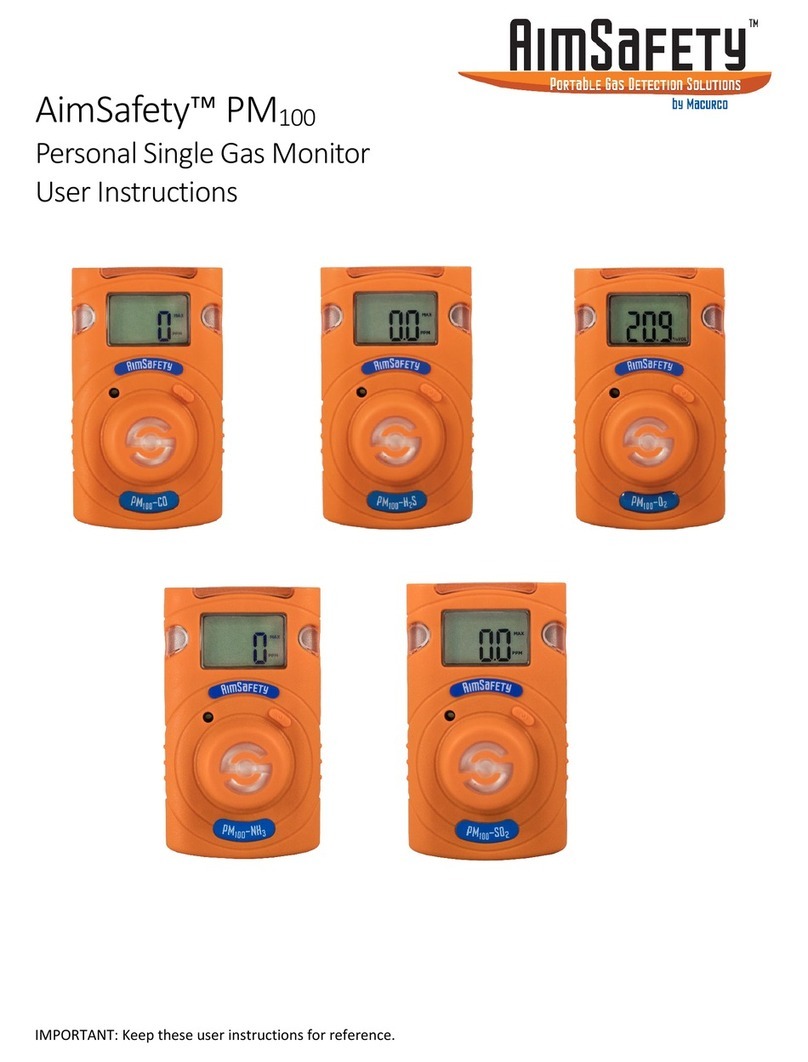
Macurco
Macurco AimSafety PM 100 User instructions
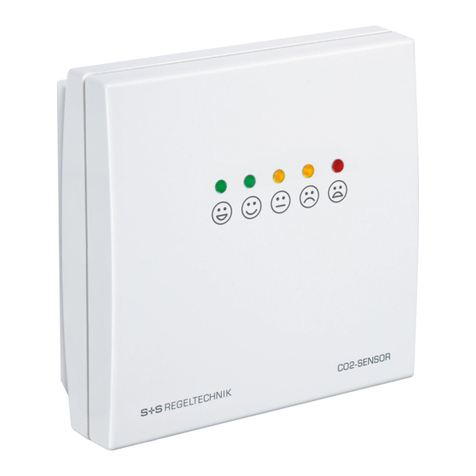
S+S Regeltechnik
S+S Regeltechnik AERASGARD RCO2-A NT operating instructions
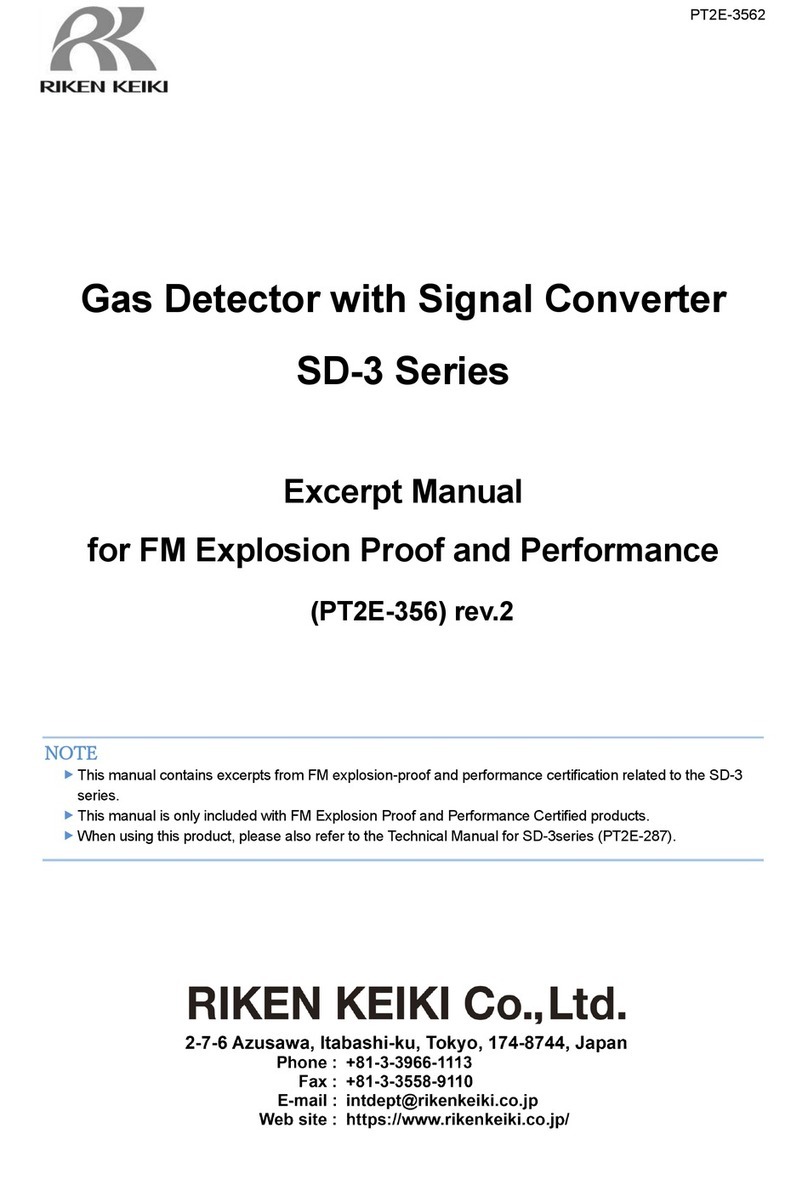
Riken Keiki
Riken Keiki SD-3 Series manual
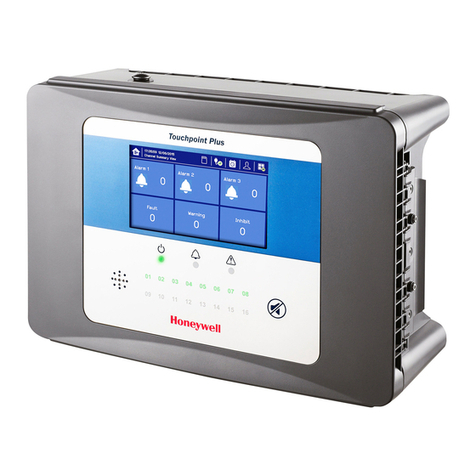
Honeywell
Honeywell Touchpoint Plus Technical handbook
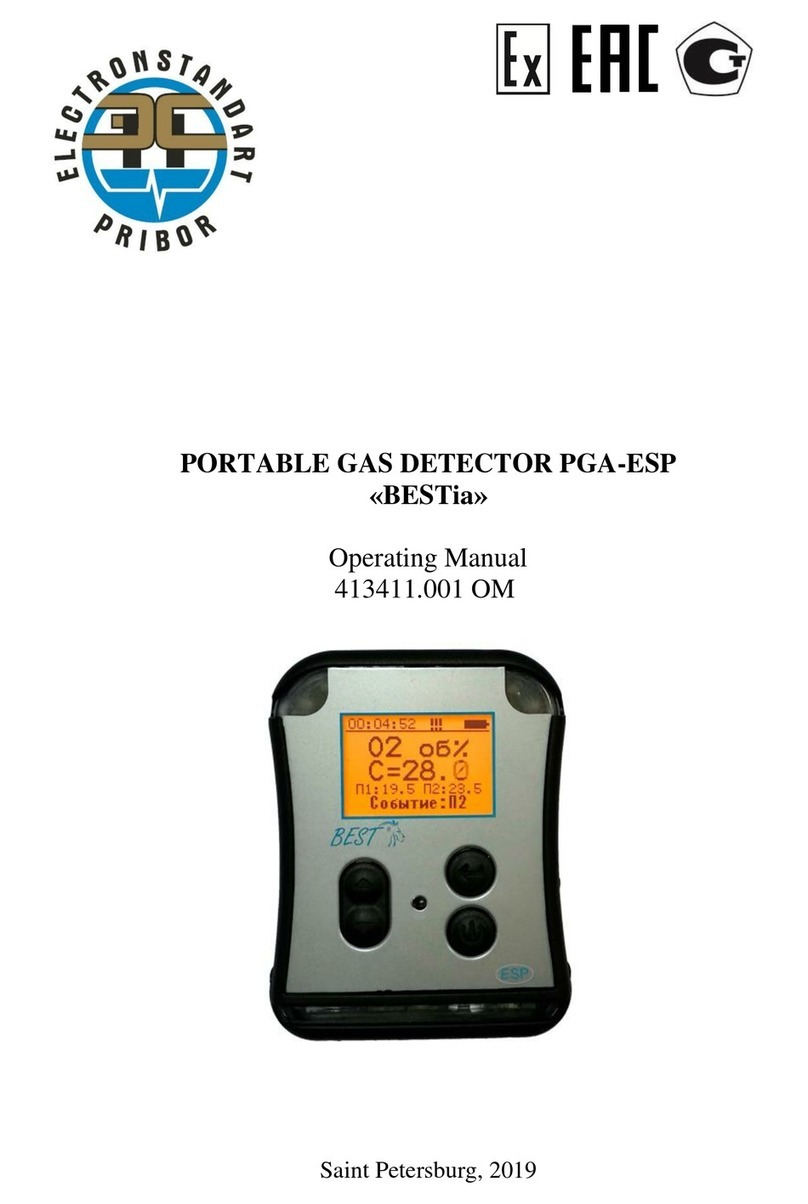
Electronstandart Pribor
Electronstandart Pribor PGA-ESP BESTia operating manual

Dräger
Dräger PointGard 2000 Series Instructions for use

